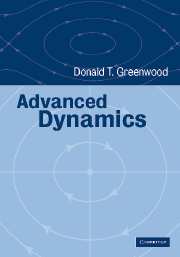3 - Kinematics and dynamics of a rigid body
Published online by Cambridge University Press: 05 June 2012
Summary
A rigid body may be viewed as a special case of a system of particles in which the particles are rigidly interconnected with each other. As a consequence, the basic principles which apply to systems of particles also apply to rigid bodies. However, there are additional kinematical and dynamical formulations which are specifically associated with rigid bodies, and which contribute greatly to their analysis. This chapter will be primarily concerned with a discussion of these topics.
Kinematical preliminaries
Degrees of freedom
The configuration of a rigid body can be expressed by giving the location of an arbitrary point in the body and also giving the orientation of the body in space. This can be accomplished by first considering a Cartesian body-axis frame to be fixed in the rigid body with its origin at the arbitrary reference point for the body. The location of the origin of this xyz body-axis frame can be given by the values of three Cartesian coordinates relative to an inertial XYZ frame. The orientation of the rigid body is specified by giving the orientation of the body axes relative to the inertial frame. This relative orientation is frequently expressed in terms of three independent Euler angles which will be defined.
The number of degrees of freedom of a rigid body is equal to the number of independent parameters required to specify its configuration which, in effect, specifies the locations of all the particles comprising the body.
- Type
- Chapter
- Information
- Advanced Dynamics , pp. 140 - 216Publisher: Cambridge University PressPrint publication year: 2003



